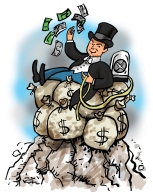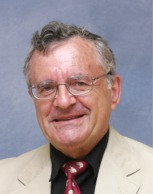2013: Tough Year for Workers, Great Year for HNWI’s
By Shlomo Maital
Illustration by Avi Katz
For most of us, 2013 was yet another hard year. The U.S. and EU economies were either in recession or barely growing. Unemployment remains high; the job market, weak. China faces slowing export growth and a housing bubble.
But it was a super-great year for HNWI’s, the Wall St. euphemism for the rich and super rich (High Net Worth Individuals), who are the focus of a huge and profitable industry known as ‘wealth management’. And wow, is there ever a lot of wealth to manage.
According to the Boston Consulting Group’s Global Wealth 2014 report, global private financial wealth grew by nearly 15 per cent last year and now totals $152 trillion, more than double world Gross Domestic Product. Wealth multiplies with ease, even when the rich do not actively work at it. Microsoft founder Bill Gates, 58, is the world’s wealthiest person, with net worth of $78 b., even though he has spent most of the past few years giving his money away. His Microsoft shares continue to generate more and more billions in wealth for him, even though he resigned as Microsoft Board Chair in February.
Capital has boomed because of urbanization and rising real estate prices, rising share prices, vast amounts of new money printed by central banks everywhere and loaned at low interest, and new capital markets in emerging nations, creating assets where none existed before. Global private wealth boomed last year because investors put money into the stock market and stock markets rose sharply. Wall Street broke all records and closed the year 23.8 per cent higher.
The wealthy have capital and so quickly accumulate more of it; the poor do not. The capital of the rich grows exponentially. The income of the poor stagnates. This is inherently unfair.
But can’t the poor rise to wealth, by hard work and saving?
The American “Horatio Alger” rags-to-riches myth is just that, according to the Equality of Opportunity Project, led by Harvard and Berkeley economists. This study found that an American child born in 1971 to parents in the poorest fifth of the income distribution had an 8.4% chance of making it to the top quintile. For a child born in 1986 the odds were 9%, basically the same. In other words, in the U.S. you have less than a one in 10 chance of rising from poverty to wealth, and it’s been that way for nearly two generations. You need to be fairly rich to go to good schools and to be accepted to good universities. In contrast, in Denmark, the probability of climbing from the bottom quintile to the top one is double that of America. If you want rags to riches, you’d better be born in Scandinavia.
If the democratic system cannot repair itself, because the super-rich control the system through high-paid lobbyists and donations to politicians — what other solution is there? The French Revolution, 1788-1804, used the guillotine; that did not work out too well for anyone and ultimately brought a dictator-emperor named Napoleon, who destroyed Europe.
The rich are different. They have money, and when they invest it, it multiplies rapidly. At 8 per cent compound interest, wealth doubles every nine years. There is nothing wrong with being rich. But when extreme wealth perpetuates itself in the manner now occurring worldwide, poverty perpetuates itself too. Trickle down? It’s a myth, too.
The rich use their wealth to make a whole lot more of it, with ease. That process does not seem to help working people much.
Unless people of good will everywhere, rich, middle-class and poor, get together to resolve this dilemma, society is simply going to fracture, perhaps violently. And that won’t be good for anyone, rich or poor.



Leave a comment
Comments feed for this article